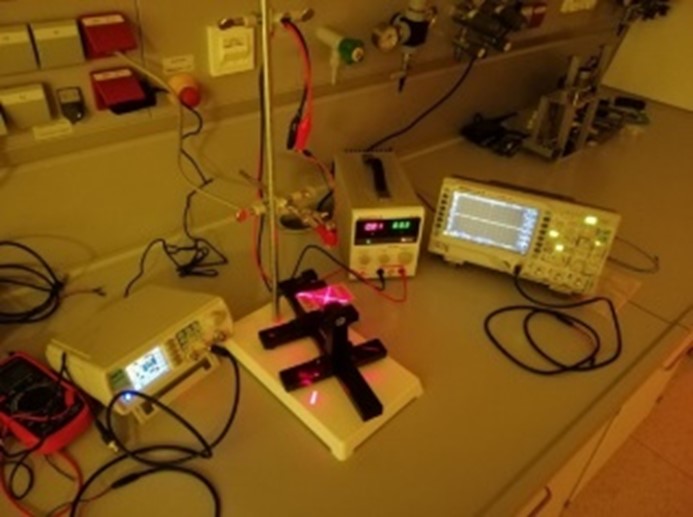Investigation of Electrical Signals Transmission through Light-Induced Conductive Channels on the Surface of CdS Single Crystal
Main Article Content
Abstract
Further development of information technologies hinges on innovations in the electronic components sector, particularly in enhancing electronic communication devices. This involves creating dynamic interconnects—electrically conductive channels that can be configured on-demand within chip circuitry to overcome the "tyranny of interconnects," which limits electronic systems due to the fixed nature of conventional interconnects.
This paper presents experimental verification of transmitting information through photoconductive channels formed on a photosensitive cadmium sulfide (CdS) semiconductor single crystal using optical irradiation. By directing a focused light beam to specific areas of the CdS crystal, localized conductivity is induced, allowing for the dynamic formation of conductive channels. This method's efficacy in real-time signal transmission validates the theoretical framework and suggests new possibilities for semiconductor technology.
The integration of dynamic interconnects could revolutionize communication systems by enhancing device efficiency and processing capabilities. This technology could lead to more complex electronic architectures needed in high-speed computing and advanced telecommunications.
Additionally, this approach has potential applications in optoelectronics, improving device interaction with light. Dynamic interconnects could enhance solar cell efficiency, increase light sensor sensitivity, and aid in developing innovative visual displays.
The ability to control material conductivity through light not only advances existing device performance but also opens doors to new electronic designs and operations. This includes fully reconfigurable circuits that adapt in real-time, self-optimizing network components, and smart sensors that respond to environmental changes.
In summary, this research not only confirms the practicality of using photoconductive channels for information transmission but also emphasizes the significant implications for electronic and communication system advancements. As this technology evolves, it promises to significantly impact the design and functionality of future electronic devices, paving the way for more adaptable and powerful systems.
Article Details

This work is licensed under a Creative Commons Attribution 4.0 International License.
Authors who publish with this journal agree to the following terms:- Authors retain copyright and grant the journal right of first publication with the work simultaneously licensed under a Creative Commons Attribution License that allows others to share the work with an acknowledgement of the work's authorship and initial publication in this journal.
- Authors are able to enter into separate, additional contractual arrangements for the non-exclusive distribution of the journal's published version of the work (e.g., post it to an institutional repository or publish it in a book), with an acknowledgement of its initial publication in this journal.
- Authors are permitted and encouraged to post their work online (e.g., in institutional repositories or on their website) prior to and during the submission process, as it can lead to productive exchanges, as well as earlier and greater citation of published work (See The Effect of Open Access).
References
R. L. Haupt, Wireless Communications Systems: An Introduction, John Wiley & Sons, Inc., 2020. DOI: https://doi.org/10.1002/9781119419204 ISBN: 978-1-11-941917-4
R. R. Chandan, "Secure Modern Wireless Communication Network Based on Blockchain Technology," Electronics, vol. 12, p. 1095, 2023. DOI: https;//doi.org/10.3390/electronics12051095
Michael Adedosu Adelabu; Agbotiname Lucky Imoize; Glory Uzuazobona Ughegbe, "Statistical analysis of radio frequency interference in microwave links using frequency scan measurements from multi-transmitter environments," Alexandria Engineering Journal, vol. 61, no. 12, pp. 11445-11484, 2022. DOI: https://doi.org/10.1016/j.aej.2022.05.019
A. Chaaban and S. Hranilovic, "Capacity of optical wireless communication channels," Philosophical Transactions of the Royal Society A, vol. 378, p. 20190184, 2020. DOI: https://doi.org/10.1098/rsta.2019.0184
S. R. Joy, M. F. Bari, M. Z. Baten, L. Feng, and P. Mazumder, "A reconfigurable interconnect technology based on spoof plasmon," in IEEE 19th International Conference on Nanotechnology (IEEE-NANO), Macao, China, 2019. DOI: https://doi.org/10.1109/NANO46743.2019.8993934
A. Ghiasi, "Large data centers interconnect bottlenecks," Optics express, vol. 23, no. 3, pp. 2085-2090, 2015. DOI: https://doi.org/10.1364/OE.23.002085
J. D. Meindl, "Beyond Moore's Law: the interconnect era," Computing in Science & Engineering, vol. 5, no. 1, pp. 20-24, 2003. DOI: https://doi.org/10.1109/MCISE.2003.1166548
Yu. M. Poplavko, V. I. Ilchenko, S. O. Voronov, Yu. I. Yakymenko, "Napivprovidnyky [Semiconductors]," in Fizychne materialoznavstvo : navch. posib. [Physical Materials Science: A Textbook], vol. 4, Kyiv, NYUU "KPI", 2011, p. 336. ISBN 978-966-622-335-0
W. Martienssen, Ed., Handbook of Condensed Matter and Materials Data, Berlin, Heidelberg, New York: Springer, 2005, p. 1143. ISBN 3-540-44376-2
"Datasheet LDR3190," 28 07 2008. [Online]. Available: https://www.sunrom.com/download/3190-LDR.pdf.
L. Rosado, Electronica Fisica y Microelectronica, Madrid: Paraninfo, 1987, p. 502. ISBN 8428315280
L. A. Nazarenko, A. I. Kolesnyk, Fizyka i tekhnika svitlodiodiv : navch. posib. [Physics and technology of LEDs: a study guide], Kharkiv: O. M. Beketov KhNUMH, 2021, p. 255. ISBN 978-966-695-560-2





